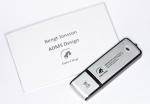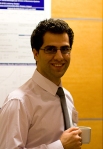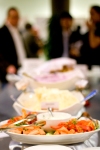
This is what coming home looked like for me on the first day after the conference (click on photo to enlarge). Lake Dellen is about to freeze. As I already told some of you at NORCHIP, I don’t live close to the nature – I live IN the nature. The barn hinted in the distance belongs to the small farm where I live. A trace of civilization and wireless infrastructure is found on top of the distant mountain. And … we have electricity too ☺.
OK, I’m back from NORCHIP since two days. I utterly failed to blog ‘live’ from the conference as I intended to. It was simply too many interesting persons to meet and presentations to hear for me to have any time for blogging. And the photo of the banquet dish that I promised as compensation failed too because of the relaxed darkness of the restaurant in which it was served. Needless to say I will not make promises like that when I go to ICECS next month, although my intention is to blog about that conference too. NORCHIP is “the Nordic microelectronics event“, so the conference is smaller than for example a European conference like ESSCIRC or ICECS, but there’s no lack of interesting people to connect with. In fact, I believe that the smaller format rather improves your chances of actually finding some time to talk to senior delegates and other people you’d like to exchange ideas with. I enjoyed the conference a lot, and below I’ll highlight a few contributions and delegates that come to mind. And, don’t be shy! If you’re not mentioned here, just post a comment below.
Professor Yong Lian, National University of Singapore (NUS), gave an invited speech titled “Towards Self-Powered Biomedical Devices”. His presentation contained many interesting technical details and also left me with a feeling that it is really exciting to be in microelectronics research because there are still so many interesting topics to investigate.
A significant part of my career has revolved around calibration of A/D-converters. I therefore listened with great interest to the invited speech “Purely-Digital versus Mixed-Signal Self-Calibration Techniques in High-Resolution Pipeline ADCs” by professor João Goes from Universidade Nova de Lisboa (UNL) . A review of different techniques to calibrate pipeline ADCs.
Data conversion contributions
Meeting the future of data-converter science, as represented by the current generation of Ph.D. students, was also rewarding. Nadeem Afzal from the Electronics Systems division, Linköping University, Sweden was the first to respond to my previous invitation to connect, and he was soon followed by his colleague M. Reza Sadeghifar. Their contributions were titled: “Study of Modified Noise-Shaper Architectures for Oversampled Sigma-Delta DACs”, and “A Higher Nyquist-Range DAC Employing Sinusoidal Interpolation”, respectively.
Other data-converter contributions during the first day were “Effects of Filtering on the Linearity of Current-steering IF DAC”, presented by Timo Rahkonen, University of Oulo, Finland, “A Low-Power, Medium-Resolution, High-Speed CMOS Pipelined ADC” by Deivasigamani Meganathan, Madras Institute of Technology, India, and “A New DFT based Approach for Gain Mismatch Detection and Correction in Time-Interleaved ADCs” by Yashar Hesamiafshar, University of Tehran, Iran.
On the second day of the conference there was more: “Calibration of ΣΔ Analog-to-Digital Converters Based on Histogram Test Methods” by Armin Jalili, Isfahan University of Technology, Iran, “A Second-Order Low-Power ΔΣ Modulator For Pressure Sensor Applications” by Tero Nieminen, Aalto University, Finland, and “An 8-bit 166nw 11.25 kS/s 0.18um two-Step-SAR ADC for RFID applications Using Novel DAC Architecture” by Iman Kianpour, Sabzevar Tarbiat Moallem University, Iran.
The conference was rounded off on the second day with the A/D-converters session where my own presentation “On CMOS Scaling and A/D-Converter Performance” was scheduled. The three other papers in our session were a second paper by Tero Nieminen, Aalto University, Finland, “An 1.2V 440-MS/s 0.13-μm CMOS Pipelined Analog-to-Digital Converter With 5-8bit Mode Selection”, “A 290μA, 3.2MHz 4-bit Phase ADC for Constant Envelope, Ultra-low Power Radio” by Budhaditya Banerjee, CSEM, Switzerland, and “Design of CMOS Sampling Switch for Ultra-Low Power ADCs in Biomedical Applications” by Dai Zhang, Linköping University, Sweden.
Unfortunately I barely managed to stay within the 20 min time slot for my paper, which didn’t leave much room for questions afterwards. So, if you have any questions on the content of my paper that you didn’t ask then you can ask them here instead. A few notes on the above:
- For brevity, the names and affiliations listed above are the first authors or presenters of each paper only – just like the conference program. If you wish to share your credit by highlighting coauthor names & affiliations you are very welcome to do so by posting a comment below.
- Some names/affiliations are left without clickable links because I couldn’t find a web domain (email) in the paper header, or the author’s personal web page at the institution. If you want, you can e-mail me the URL, and I’ll make an update so that readers can find you more easily.
- If there is any ADC/DAC paper that I failed to mention, or if you feel that I have misrepresented you or your affiliation in any way, just send me an e-mail, and I’ll correct it.
- Even if you didn’t go to NORCHIP this year, you will eventually find all the papers on IEEE Xplore. Edit: NORCHIP 2010 is now available on IEEE Explore here, and if you specifically want to check out my paper, start here.
Other impressions from NORCHIP 2010

Microelectronics scientists enjoy the fruit of their own labour. Thanks to the research in our own field, the size of conference proceedings is now about 25% of the conference badges.
I want to particularly thank anyone involved in memory research for the technology enabling us to have conference proceedings that are 25% the size of our conference badges. Effectively, it means that we are enjoying the fruits of our own research as it makes our conferencing more comfortable. On the other hand, the NORCHIP proceedings were never close to the 3–6 volumes a typical ISCAS could produce, so maybe it wasn’t such a big difference for everyone. Nevertheless, I liked it. And … it does make a huge difference for the conference coordinator since 1985, Ivan Ring Nielsen, Technoconsult ApS, Denmark, who introduced the USB proceedings in 2007. He no longer has to lug around 60–100kg of printed proceedings every year, and instead of paying excessive-weight charges to airlines, he can now invest all that extra money in the conference food budget 🙂
Scientific efforts tend to make you really hungry, so an important aspect of any conference is the food. Not only the banquet dinner, but also the lunches, coffee breaks and snacks. The “hub” of conference networking is to a large degree the opportunity to talk to each other during coffee, lunch and dinner breaks, so it should be good. And it was. I can highly recommend Scandic Tampere City for conferences of a similar format. Excellent job! The salad bar at lunch time was one of my favourites. Because of all the nice offerings, I filled my plate to 80% with veggies, leaving space only for a tablespoon or two of the main dish. I am a die-hard red meat lover that think the green stuff is best used to feed the critters I hope to grill sometime in the future, so that was a very high rating for the salad bar.
Poster sessions blend particularly well with coffee breaks, and what could be a better snack for data-converter designers than “mixed seeds”? I assume the large green seeds must be the analog, and the small white seeds the digital that shrunk with process scaling.
Faithful readers of this blog will have figured out by now that I love pie charts almost as much as I love pie, and if you have read this far you may be wondering if I’m not going to serve you any pie chart in this post. Yes, I will!
In case anyone is curious about the delegates you can expect to meet at NORCHIP 2011 in Lund next year, I’ve compiled a pie-chart showing the country of affiliation for this years NORCHIP delegates (from the official list of participants). As expected, it appears that a majority of delegates are from affiliations in Finland, Norway and Sweden, but delegates came from as far away as Iran, India, Singapore, Japan, and USA. And before signing up for a crash course in casual conversation using Scandinavian languages, you may want to consider that research knows few boundaries, and therefore the country of affiliation does not always reflect the nationality of the participant. In fact, the fast growth of research in Asia discussed in the previous post is clearly evident also from the many visiting Ph.D. students in Nordic countries, and just as visible at NORCHIP.
NORCHIP is therefore a much more international event than its label reveals.








Pingback: Anyone going to ICECS 2010? | Converter Passion
Pingback: Connect with Converter Passion at IWADC 2011 | Converter Passion
Pingback: Back from ECCTD 2011 | Converter Passion